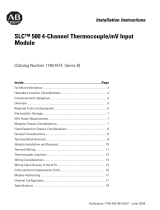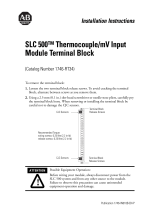Page is loading ...

Publication 1746-5.23
SLC 500 Thermocouple/mV Analog
Input Module
(Catalog Number 1746-NT8)
Installation Instructions
Inside...
Important User Information . . . . . . . . . . . . . . . . . . . . . . . . . 2
For More Information. . . . . . . . . . . . . . . . . . . . . . . . . . . . . . 3
Module Overview. . . . . . . . . . . . . . . . . . . . . . . . . . . . . . . . . 4
Input Ranges. . . . . . . . . . . . . . . . . . . . . . . . . . . . . . . . . . . . 5
Hardware Features . . . . . . . . . . . . . . . . . . . . . . . . . . . . . . . 6
Installing And Wiring Your Module . . . . . . . . . . . . . . . . . . . 8
Electrostatic Damage . . . . . . . . . . . . . . . . . . . . . . . . . . . . . 8
Required Tools and Equipment. . . . . . . . . . . . . . . . . . . . . . 9
Power Requirements. . . . . . . . . . . . . . . . . . . . . . . . . . . . . . 9
Considerations for a Modular System. . . . . . . . . . . . . . . . . 10
Considerations for a Fixed Controller . . . . . . . . . . . . . . . . . 10
Selecting A Rack Slot . . . . . . . . . . . . . . . . . . . . . . . . . . . . . 10
Module Installation and Removal . . . . . . . . . . . . . . . . . . . . 11
Terminal Block Removal . . . . . . . . . . . . . . . . . . . . . . . . . . . 12
Cold Junction Compensation (CJC) . . . . . . . . . . . . . . . . . . 13
Wiring Guidelines . . . . . . . . . . . . . . . . . . . . . . . . . . . . . . . . 14
Thermocouple Junctions. . . . . . . . . . . . . . . . . . . . . . . . . . . 14
Preparing and Wiring the Cables . . . . . . . . . . . . . . . . . . . . 18
Module Specifications . . . . . . . . . . . . . . . . . . . . . . . . . . . . . 21
Spare Allen-Bradley Parts

2 SLC 500 Thermocouple/mV Analog Input Module
Publication 1746-5.23
,PSRUWDQW8VHU,QIRUPDWLRQ
Because of the variety of uses for the products described in this publication, those
responsible for the application and use of this control equipment must satisfy
themselves that all necessary steps have been taken to assure that each
application and use meets all performance and safety requirements, including any
applicable laws, regulations, codes and standards.
The illustrations, charts, sample programs and layout examples shown in this
guide are intended solely for purposes of example. Since there are many
variables and requirements associated with any particular installation,
Allen-Bradley does not assume responsibility or liability (to include intellectual
property liability) for actual use based upon the examples shown in this
publication.
Allen-Bradley publication SGI-1.1, Safety Guidelines for the Application,
Installation, and Maintenance of Solid-State Control (available from your local
Allen-Bradley office), describes some important differences between solid–state
equipment and electromechanical devices that should be taken into consideration
when applying products such as those described in this publication.
Reproduction of the contents of this copyrighted publication, in whole or in part,
without written permission of Allen-Bradley Company, Inc., is prohibited.
Throughout these installation instructions we use notes to make you aware of
safety considerations:
Attention statements help you to:
• identify a hazard
• avoid the hazard
• recognize the consequences
!
ATTENTION: Identifies information about practices or
circumstances that can lead to personal injury or death, property
damage or economic loss.
Important:
Identifies information that is critical for successful application and
understanding of the product.

SLC 500 Thermocouple/mV Analog Input Module 3
Publication 1746-5.23
For More Information
As part of our effort to preserve, protect, and improve our environment, Allen-
Bradley is reducing the amount of paper we use. Less paper means more options
for you. In addition to traditional printed publications and CD-ROM versions, we
now offer on-line manuals with the most up-to-date information you can get. We
recommend that you read the related publications listed below before starting up
your control system.
Related Publications
How to Get More Information
If you would like a manual, you can:
• download a free electronic version from the internet at
www.theautomationbookstore.com
• purchase a manual by:
— contacting your local distributor or Rockwell Automation
representative
— visiting www.theautomationbookstore.com and placing your order
— calling 1.800.963.9548 (USA/Canada) or 001.330.725.1574 (Outside
USA/Canada)
For Refer to this Document Pub. No.
A more detailed description on how to install
and use your SLC 500™ Thermocouple/mV
Input Module
SLC 500™ Thermocouple/
mV Analog Input Module
User Manual
1746-6.22
A more detailed description on how to install
and use your SLC 500™ Modular Hardware
Style Control System.
SLC 500™ Modular
Hardware Style Installation
and Operation Manual
1747-6.2
More information on proper wiring and
grounding techniques.
Automation Wiring and
Grounding Guidelines
1770-4.1
Spare Allen-Bradley Parts

4 SLC 500 Thermocouple/mV Analog Input Module
Publication 1746-5.23
Module Overview
The module communicates with the SLC 500 processor and receives +5V dc and
+24V dc power from the system power supply through the parallel backplane
interface. No external power supply is required. You may install as many
thermocouple modules in the system as the power supply can support.
Each module channel can receive input signals from a thermocouple or a
millivolt analog input device. You configure each channel to accept either one.
The module converts analog input voltages when it is configured for
thermocouple input types. The analog input voltages are converted into cold-
junction compensated, digital temperature readings. The module uses the
National Institute of Standards and Technology (NIST) based on ITS-90 for
thermocouple linearization.
When configured for millivolt analog inputs, the module converts analog values
directly into digital counts. The module assumes that the mV input signal is
linear prior to input to the module.

SLC 500 Thermocouple/mV Analog Input Module 5
Publication 1746-5.23
Input Ranges
The following tables define thermocouple types and associated temperature
ranges and the millivolt analog input signal ranges that each of the module’s
input channels will support. To determine the practical temperature range of your
thermocouple, refer to the specifications in Appendix A of the SLC 500
Thermocouple/mV Analog Input Module User Manual, publication 1746-6.22.
Thermocouple Temperature Ranges
Millivolt Input Ranges
Each input channel is individually configured for a specific input device. Each
channel detects and indicates:
• open-circuit
• over-range
• under-range
Type °C Temperature Range °F Temperature Range
J -210 °C to 760 °C -346 °F to 1400 °F
K -270 °C to 1370 °C -454 °F to 2498 °F
T -270 °C to 400 °C -454 °F to 752 °F
B 300 °C to 1820 °C 572 °C to 3308 °F
E -270 °C to 1000 °C -454 °F to 1832 °F
R 0 °C to 1768 °C 32 °F to 3214 °F
S 0 °C to 1768 °C 32 °F to 3214 °F
N 0 °C to 1300 °C 32 °F to 2372 °F
CJC Sensor -25 °C to 105 °C -13 °F to 221 °F
-50 to +50 mV
-100 to +100 mV
Spare Allen-Bradley Parts

6 SLC 500 Thermocouple/mV Analog Input Module
Publication 1746-5.23
Hardware Features
The module fits into any single slot (other than slot 0) for I/O modules in either
an SLC 500 modular system or an SLC 500 fixed system expansion chassis
(1746-A2). It is a Class 1
1
module (uses 8 input words and 8 output words).
The module contains a removable terminal block providing connections for eight
thermocouple and/or analog input devices. On the terminal block are two cold-
junction compensation (CJC) sensors that compensate for the cold junction at
ambient temperature. It should also be noted there are no output channels on the
module. Configure the module with software rather than with jumpers or
switches.
1. Requires use of a Block Transfer in a remote configuration.
Important:
There is a jumper (JP1) on the circuit board. The module is
shipped with the jumper in the up position as illustrated below. Do
not change the position of JP1. The jumper is used for test
purposes only.
JP1
Jumper - Do Not move.

SLC 500 Thermocouple/mV Analog Input Module 7
Publication 1746-5.23
1746-NT8 Features
Hardware Function
Channel Status LED Indicators Display operating and fault status of channels 0-7
Module Status LED Displays operating and fault status of the module
Side Label (Nameplate) Provides module information
Removable Terminal Block Provides electrical connection to input devices
Door Label Permits easy terminal identification
Self Locking Tabs Secure module in chassis slot
MODULE
0
1
4
5
2
1
2
3
CHANNEL
STATUS
THERMOCOUPLE/mV
INPUT
CJC A+
CJC A-
CHL 0+
CHL 0-
SHIELD
CHL 1+
CHL 1-
CHL 2+
CHL 2-
SHIELD
CHL 3+
CHL 3-
CHL 4+
CHL 4-
SHIELD
CHL 5+
CHL 5-
CHL 6+
CHL 6-
SHIELD
CHL 7+
CHL 7-
CJC B+
CJC B-
1746-NT8
Door Label
Channel Status
LEDs (Green)
Module Status
LED (Green)
Removable
Terminal Block
CJC Sensors
Cable Tie Slots
Spare Allen-Bradley Parts

8 SLC 500 Thermocouple/mV Analog Input Module
Publication 1746-5.23
Installing And Wiring Your Module
Read this section to install and wire your module. This section covers:
• avoiding electrostatic damage
• determining power requirements
• installing the module
• wiring signal cables to the module’s terminal block
Electrostatic Damage
Electrostatic discharge can damage semiconductor devices inside this module if
you touch backplane connector pins. Guard against electrostatic damage by
observing the following precautions:
!
ATTENTION: ELECTROSTATICALLY SENSITIVE
COMPONENTS
• Before handling the module, touch a grounded object to rid
yourself of electrostatic charge.
• Handle the module from the front, away from the backplane
connector. Do not touch backplane connector pins.
• Keep the module in its static-shield container when not in
use or during shipment.
Failure to observe these precautions can degrade the module’s
performance or cause permanent damage.

SLC 500 Thermocouple/mV Analog Input Module 9
Publication 1746-5.23
Required Tools and Equipment
Have the following tools and equipment ready:
• 2.5 mm (0.1 in.) slot-head screwdriver
• thermocouple or millivolt sensor
• appropriate thermocouple extension wire (if needed)
• thermocouple/mV input module (1746-NT8)
• programming equipment
Power Requirements
The module receives its power through the SLC 500 chassis backplane from the
fixed or modular +5V dc/+24V dc chassis power supply. The maximum current
drawn by the module is shown in the following table.
Maximum Current Drawn By the Module
5VDC Amps 24VDC Amps
0.120 0.070
Spare Allen-Bradley Parts

10 SLC 500 Thermocouple/mV Analog Input Module
Publication 1746-5.23
Considerations for a Modular System
Place your module in any slot of an SLC 500 modular, or modular expansion
chassis, except for the left-most slot (slot 0) reserved for the SLC processor or
adapter modules.
Considerations for a Fixed Controller
The power supply in the 2-slot SLC 500 fixed I/O chassis (1746-A2) can support
only specific combinations of modules. Make sure the chassis power supply can
support the 1746-NT8 and additional module power requirements.
Selecting A Rack Slot
Two factors determine where you should install your module in the rack: ambient
temperature and electrical noise. When selecting a slot for your module, try to
position your module:
• in a rack close to the bottom of the enclosure (where the air is cooler)
• away from modules that generate significant heat, such as the 1746-OA16
or the 1746-IA16
• in a slot away from ac or high-voltage dc modules, hard contact switches,
relays, and ac motor drives
• away from the rack power supply (if using a modular system)
Remember that in a modular system, a processor or adapter always occupies the
first slot of the rack.

SLC 500 Thermocouple/mV Analog Input Module 11
Publication 1746-5.23
Module Installation and Removal
To insert your module into the rack, follow these steps:
1. Before installing the module, connect ground wire to TB1. See page 19.
2. Align the circuit board of your module with the card guides at the top and
bottom of the chassis.
3. Slide your module into the chassis until both top and bottom retaining clips
are secure. Apply firm even pressure on your module to attach it to its
backplane connector. Never force your module into the slot.
4. Cover all unused slots with the Card Slot Filler, Allen-Bradley part number
1746-N2.
!
ATTENTION: Before installing or removing your module,
always disconnect:
• power from the SLC 500 system
• any other power sources to the module
• any devices wired to the module
Failure to observe this precaution can cause unintended
equipment operation and damage.
Top and Bottom
Module Release(s)
Card
Guide
Spare Allen-Bradley Parts

12 SLC 500 Thermocouple/mV Analog Input Module
Publication 1746-5.23
Terminal Block Removal
To remove the terminal block:
1. Loosen the two terminal block release screws. To avoid cracking the
terminal block, alternate between screws as you remove them.
2. Using a screwdriver or needle-nose pliers, carefully pry the terminal block
loose. When removing or installing the terminal block be careful not to
damage the CJC sensors.
Terminal Block Diagram with CJC Sensors
!
ATTENTION: POSSIBLE EQUIPMENT OPERATION
Before wiring your module, always disconnect power from the
SLC 500 system and from any other source to the module.
Failure to observe this precaution can cause unintended
equipment operation and damage.
Terminal Block
Release Screws
CJC Sensors
CJC Sensors
Terminal Block
Release Screws

SLC 500 Thermocouple/mV Analog Input Module 13
Publication 1746-5.23
Cold Junction Compensation (CJC)
To obtain accurate readings from each of the channels, the cold-junction
temperature (temperature at the module’s terminal junction between the
thermocouple wire and the input channel) must be compensated for. Two cold
junction compensating sensors are integrated in the removable terminal block.
They must remain installed to retain accuracy.
!
ATTENTION: Do not remove or loosen the cold junction
compensating temperature transducers located on the terminal
block. Both CJCs are critical to ensure accurate thermocouple
input readings at each channel. The module will not operate in
thermocouple mode if a CJC is not connected.
Failure to observe this precaution can cause unintended
equipment operation and damage.
Spare Allen-Bradley Parts

14 SLC 500 Thermocouple/mV Analog Input Module
Publication 1746-5.23
Wiring Guidelines
Isolation
7KH17PRGXOHSURYLGHVWKHIROORZLQJHOHFWULFDOLVRODWLRQ
• 12.5V dc electrical isolation channel to channel
• 500V dc electrical isolation channel to chassis ground
• 500V dc electrical isolation channel to backplane
Care must be taken when choosing a thermocouple type and connecting it to the
1746-NT8 module from the environment being measured. If adequate
precautions are not taken for a given thermocouple type, the electrical isolation
of the 1746-NT8 module may be compromised.
Thermocouple Junctions
There are three types of thermocouple junctions:
• Grounded Junction - The measuring junction is physically connected to the
protective metal sheath providing electrical continuity between junction and
sheath.
• Ungrounded Junction - The measuring junction is electrically isolated from
the protective metal sheath. (Ungrounded Junction can also be called
Insulated Junction.)
• Exposed Junction - Does not have a protective metal sheath so the
measuring junction is exposed.
Note: Please refer to Appendix A of the SLC 500 Thermocouple/mV
Analog Input User Manual, publication 1746-6.22 for additional
information on wiring and using grounded junction, ungrounded
junction, and exposed junction thermocouple types.

SLC 500 Thermocouple/mV Analog Input Module 15
Publication 1746-5.23
Grounded Junction Thermocouples
As shown in the following illustration, the shield input terminals are internally
connected together, which are then connected to chassis ground. Using grounded
junction thermocouples with electrically conductive sheaths removes the
thermocouple signal to chassis ground isolation of the module. This is inherent to
the thermocouple construction. In addition, if multiple grounded junction
thermocouples are used, the module’s channel-to-channel isolation is removed
since there is no isolation between signal and sheath and the sheaths are tied
together. It should be noted that the isolation is removed even if the sheaths are
connected to chassis ground at a location other than the module, since the module
is connected to chassis ground.
As shown in the above wiring diagram, it is recommended that grounded junction
thermocouples have either protective sheaths made of electrically insulated
material (e.g. ceramic), or that the metal protective sheaths be floated. The metal
sheaths would need to be floated with respect to any path to chassis ground or to
another thermocouple metal sheath. This means the metal sheath must be
insulated from electrically conductive process material and have all connections
to chassis ground broken. It should be noted that a floated sheath may result in a
less noise-immune thermocouple signal.
+
-
+
-
1746-NT8
Grounded junction with nonconductive
protective sheath
CH0
MUXES
CH3
Metal sheath with electrical continuity to
thermocouple signal wires.
(floating ground connection)
Spare Allen-Bradley Parts

16 SLC 500 Thermocouple/mV Analog Input Module
Publication 1746-5.23
Exposed Junction Thermocouples
5HFRPPHQGHGZLULQJIRUH[SRVHGMX QFWLRQWKHUPRFRXSOHVLVVKRZQLQWKH
IROORZLQJLOOXVWUDWLRQ8VLQJH[SRVHGMXQFWLRQWKHUPRFRXSOHVPD\UHVXOWLQ
UHPRYDORIFKDQQHOWRFKDQQHOLVRODWLRQ7KLVPD\RFFXULIPXOWLSOHH[SRVHG
WKHUPRFRXSOHVDUHLQGLUHFWFRQWDFWZLWKHOHFWULFDOO\FRQGXFWLYHSURFHVV
PDWHULDOV7RSUHYHQWYLRODWLRQRIFKDQQHOWRFKDQQHOLVRODWLRQ
)RUPXOWLSOHH[SRVHGWKHUPRFRXSOHVGRQRWDOORZWKHPHDVXULQJ
MXQFWLRQRIWKHWKHUPRFRXSOHWRPDNHGLUHFWFRQWDFWZLWKHOHFWULFDOO\
FRQGXFWLYHSURFHVVPDWHULDO
8VHDOOXQJURXQGHGMXQFWLRQWKHUPRFRXSOHVLQVWHDGRIWKHH[SRVHG
MXQFWLRQW\SH
+
-
+
-
1746-NT8
Conductive Material
Exposed junction with
shielded cable
CH 0
MUXES
Nonconductive Material
Exposed junction with
shielded cable
CH 3

SLC 500 Thermocouple/mV Analog Input Module 17
Publication 1746-5.23
Cable Wiring Considerations
Follow these guidelines to wire your input signal cables:
• Power, input, and output (I/O) wiring must be in accordance with Class 1,
Division 2 wiring methods [Article 501-4(b) of the National Electrical
Code, NFPA 70] and in accordance with the authority having jurisdiction.
• Route the field wiring away from any other wiring and as far as possible
from sources of electrical noise, such as motors, transformers, contactors,
and ac devices. As a general rule, allow at least 15.2 cm (6 in.) of separation
for every 120 V of power.
• Routing the field wiring in a grounded conduit can reduce electrical noise
further.
• If the field wiring must cross ac or power cables, ensure that they cross at
right angles.
• To limit the pickup of electrical noise, keep thermocouple and millivolt
signal wires as far from power and load lines as possible.
• For high immunity to electrical noise, use Belden™ 8761 (shielded, twisted
pair) or equivalent wire for millivolt sensors; you can also use shielded,
twisted pair thermocouple extension lead wire specified by the
thermocouple manufacturer. Using the incorrect type of thermocouple
extension wire or not following the correct polarity may cause invalid
readings.
• Ground the shield drain wire at only one end of the cable. The preferred
location is at the shield connections on the terminal block. (Refer to IEEE
Std. 518, Section 6.4.2.7 or contact your sensor manufacturer for additional
details.)
• Keep all unshielded wires as short as possible.
• Excessive tightening can strip a screw. Tighten screws no more than
0.25 Nm.
• Follow system grounding and wiring guidelines found in your SLC 500
Installation and Operation Manual.
Spare Allen-Bradley Parts

18 SLC 500 Thermocouple/mV Analog Input Module
Publication 1746-5.23
Preparing and Wiring the Cables
To prepare and connect cable leads and drain wires, follow these steps:
1. At each end of the cable, strip some casing to expose individual wires.
2. Trim signal wires to 5-inch lengths beyond the cable casing. Strip about
4.76 mm (0.1875 in.) of insulation to expose the ends of the wires.
3. At the module-end of the cables:
• extract the drain wire and signal wires
• remove the foil shield
• bundle the input cables with a cable strap
4. Connect the following pairs of drain wires together.
• Channels 0 and 1
• Channels 2 and 3
• Channels 4 and 5
• Channels 6 and 7
Keep drain wires as short as possible.
5. Connect the drain wires to the shield inputs of the terminal block if
appropriate for thermocouple used. See “Wiring Guidelines” on page 14 for
more information.
• Channel 0 and 1 drain wires to pin 5
• Channel 2 and 3 drain wires to pin 10
• Channel 4 and 5 drain wires to pin 15
• Channel 6 and 7 drain wires to pin 20
(Remove foil shield
and drain wire from
sensor-end of the
cable.)
Cable
Drain Wire
Signal Wires
Signal Wires

SLC 500 Thermocouple/mV Analog Input Module 19
Publication 1746-5.23
6. Connect the signal wires of each channel to the terminal block.
7. Connect TB1 chassis ground connector to the nearest chassis mounting bolt
with 14 gauge wire. (On the face of the module, TB1 is near the lower part
of the terminal block on the primary side of the PCB.)
8. At the sensor-end of cables from thermocouple/mV devices:
• remove the drain wire and foil shield
• apply shrink wrap as an option
• connect to thermocouple/mV devices keeping the leads short
Important:
Only after verifying that your connections are correct for each
channel, trim the lengths to keep them short. Avoid cutting
leads too short.
Important:
If noise persists, try grounding the opposite end of the cable
instead. (Ground one end only.)
TB1
Connect ground wire to TB1
before installing module.
Spare Allen-Bradley Parts

20 SLC 500 Thermocouple/mV Analog Input Module
Publication 1746-5.23
Terminal Block Diagram with Input Cable
Thermocouple or
mV Cable
CJC A+
CJC A-
Channel 0+
Channel 0-
Shield for CH0 and CH1
Channel 1+
Channel 1-
Channel 2+
Channel 2-
Shield for CH2 and CH3
Channel 3+
Channel 3-
Channel 4+
Channel 4-
Shield for CH4 and CH5
Channel 5+
Channel 5-
Channel 6+
Channel 6-
Shield for CH6 and CH7
Channel 7+
Channel 7-
CJC B+
CJC B-
TB1
/




